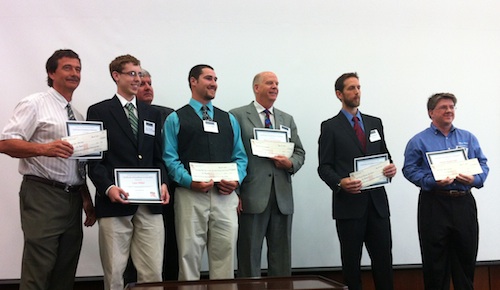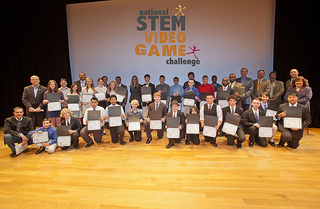On December 15th, FOSS@RIT of the RIT Lab for Technological Literacy hosted the first of two Hackathons for the National STEM Video Game Challenge. A Hackathon is like a marathon, but rather than running, people are coding. Hackathons provide a collaborative environment of like-minded folks, who help each other solve problems, experiment with new concepts, and tackle particular tasks, features, or bugs in a coding project. A typical hackathon here lasts anywhere from 8 and 48 caffeine fueled hours. Below is the description of the STEM Video Game Challenge cribbed from STEMChallenge.org’s About Page:
“Inspired by the Educate to Innovate Campaign, President Obama’s initiative to promote a renewed focus on Science, Technology, Engineering, and Math (STEM) education, the National STEM Video Game Challenge is a multi-year competition whose goal is to motivate interest in STEM learning among America’s youth by tapping into students’ natural passion for playing and making video games.
The 2012 National STEM Video Game Challenge is launched in partnership with Digital Promise, a new initiative created by the President and Congress, supported through the Department of Education. The initiative is designed to unlock the promise of breakthrough technologies to transform teaching and learning.”
More than two dozen students and community mentors attended the event over the course of the hackfest to work together and to support other teams, which is capped at four members. A number of student teams got some brainstorming and project planning under their belt before leaving for Winter Break, even if they didn’t officially release their plans just yet. Below are pictures of the event, and a breakdown of two teams willing to share their ideas. Since both teams arel under the four person threshhold, they are open to collegiate contributors joining their ranks.
|
|
| Team Name | Team Members | URLs | Entry Stream | ||
|---|---|---|---|---|---|
| Artwork Evolution |
Steve Brunwasser – 2nd year Computer Science |
Middle School Prize | |||
| Not just a ‘standard game’ but an interactive math and art tool. It is a combination taking principles from math, and applying them in new ways to create art. You can interact with the math to change how the art looks. You can take images, and breed them to collaborate with other people in a ‘multi-player’ setting. You could share the mathematic ‘DNA’ of your art with others, they can change it, and create new works to share. The goal for younger students is to create organic and abstract images, through experimentation and real-time feedback. | |||||
| Elemental Shift |
|
|
Middle School Prize or Sesame Street Prize (if implemented in HTML5) |
||
| Casual Game based on pattern matching mechanics. Aims to teach spatial reasoning and pattern recognition through the precesses of observation, investigation, and analysis. A player will be presented with a matrix of colored shapes. the object of the game is to construct matching blocks of color, similar to games like Bejeweled and Tetris. The player selects regions of the game board, and performs transformations to attempt to match as many colored shapes as possible. The game could include a resource management mechanic to incentivize large pattern matches, or a time constraint mechanic to perform as many matches in a set amount of time. Difficulty levels would be variable, and based upon performance of the player (i.e. the better the performance, the harder the difficulty gets) | |||||
FOSS@RIT will be hosting Round Two of the STEM Video Game Challenge Hackathon on February 2nd, 2012. The hackathon will be attended by former attendees, students from RIT’s FLOSS Seminar in Interactive Games and Media, and community members who would like to join us. For more information visit the http://foss.rit.edu/stem12. Questions/Comments/RSVP to remydcsi(at)rit(dot)edu.
For more on the Cooney Center’s coverage of STEM Challenge events and winners, browse these photos and videos




